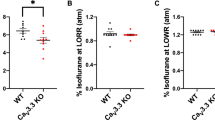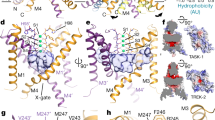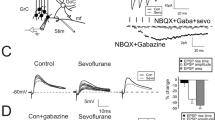Abstract
Volatile anesthetics produce safe, reversible unconsciousness, amnesia and analgesia via hyperpolarization of mammalian neurons. In molluscan pacemaker neurons, they activate an inhibitory synaptic K+ current ( IKAn), proposed to be important in general anesthesia. Here we show that TASK and TREK-1, two recently cloned mammalian two-P-domain K+ channels similar to IKAn in biophysical properties, are activated by volatile general anesthetics. Chloroform, diethyl ether, halothane and isoflurane activated TREK-1, whereas only halothane and isoflurane activated TASK. Carboxy (C)-terminal regions were critical for anesthetic activation in both channels. Thus both TREK-1 and TASK are possibly important target sites for these agents.
This is a preview of subscription content, access via your institution
Access options
Subscribe to this journal
Receive 12 print issues and online access
$209.00 per year
only $17.42 per issue
Buy this article
- Purchase on Springer Link
- Instant access to full article PDF
Prices may be subject to local taxes which are calculated during checkout






Similar content being viewed by others
References
Nicoll, R. A. & Madison, D. V. General anesthetics hyperpolarize neurons in the vertebrate central nervous system. Science 217, 1055–1077 (1982).
Berg-Johnsen, J. & Langmoen, I. A. Isoflurane hyperpolarizes neurones in rat and human cerebral cortex. Acta Physiol. Scand. 130, 679–685 (1987).
Felisberti, F., Antkowiak, B. & Kirschfeld, K. Effects of volatile anesthetics on the membrane potential and ion channels of cultured neocortical astrocytes. Brain Res. 766, 56–65 ( 1997).
MacIver, M. B. & Kendig, J. J. Anesthetic effects on resting membrane potential are voltage-dependent and agent-specific. Anesthesiology 74, 83–88 ( 1991).
Franks, N. P. & Lieb, W. R. Volatile general anesthetics activate a novel neuronal K+ current. Nature 333, 662–664 (1988).
Franks, N. P. & Lieb, W. R. Stereospecific effects of inhalational general anesthetic optical isomers on nerve ion channels. Science 254, 427–430 ( 1991).
Winegar, B. D., Owen, D. F., Yost, C. S., Forsayeth, J. R. & Mayeri, E. Volatile general anesthetics produce hyperpolarization of Aplysia neurons by activation of a discrete population of baseline potassium channels. Anesthesiology 85, 889 –900 (1996).
Franks, N. P. & Lieb, W. R. Molecular and cellular mechanisms of general anesthesia. Nature 367, 607– 614 (1994).
Lopes, C. M., Franks, N. P. & Lieb, W. R. Actions of general anesthetics and arachidonic acid pathway inhibitors on K+ currents activated by volatile anesthetics and FMRFamide in molluscan neurones. Br. J. Pharmacol. 125, 309–318 (1998).
Sirois, J. E., Pancrazio, J. J., Lynch, C. & Bayliss, D. A. Multiple ionic mechanisms mediate inhibition of rat motoneurones by inhalation anaesthetics. J. Physiol. (Lond.) 512, 851 –862 (1998).
Duprat, F. et al. TASK, a human background K+ channel to sense external pH variations near physiological pH. EMBO J. 16, 5464–5471 (1997).
Fink, M. et al. Cloning, functional expression and brain localization of a novel unconventional outward rectifier K+ channel. EMBO J. 15, 6854–6862 ( 1996).
Fink, M. et al. A neuronal two P domain K+ channel stimulated by arachidonic acid and polyunsaturated fatty acids. EMBO J. 17, 3297–3308 (1998).
Lesage, F. et al. TWIK-1, a ubiquitous human weakly inward rectifying K+ channel with a novel structure. EMBO J. 15 , 1004–1011 (1996).
Lesage, F. et al. Dimerization of TWIK-1 K+ channel subunits via a disulfide bridge. EMBO J. 15, 6400 –6407 (1996).
Patel, A. et al. A mammalian two pore domain mechano-gated S-type K+ channel. EMBO J. 17, 4283– 4290 (1998).
Mihic, S. J. et al. Sites of alcohol and volatile anesthetic action on GABA(A) and glycine receptors. Nature 389, 385– 389 (1997).
Harris, R. A., Mihic, S. J., Dildy-Mayfield, J. E. & Machu, T. K. Actions of anesthetics on ligand-gated ion channels: role of receptor subunit composition. FASEB J. 9, 1454– 1462 (1995).
Lesage, F. et al. A pH-sensitive yeast outward rectifier K+ channel with two pore domains and novel gating properties. J. Biol. Chem. 271, 4183–4187 ( 1996).
Ketchum, K. A., Joiner, W. J., Sellers, A. J., Kaczmarek, L. K. & Goldstein, S. A. A new family of outwardly rectifying potassium channel proteins with two pore domains in tandem. Nature 376, 690–695 ( 1995).
Zhou, X. L., Vaillant, B., Loukin, S. H., Kung, C. & Saimi, Y. YKC1 encodes the depolarization-activated K+ channel in the plasma membrane of yeast. FEBS Lett. 373, 170–176 ( 1995).
Reid, J. D. et al. The S. cerevisiae outwardly-rectifying potassium channel (DUK1) identifies a new family of channels with duplicated pore domains. Receptors Channels 4, 51–62 (1996).
Gray, A. T., Winegar, B. D., Leonoudakis, D. J., Forsayeth, J. R. & Yost, C. S. TOK1 is a volatile anesthetic stimulated K+ channel. Anesthesiology 88, 1076–1084 ( 1998).
Yon, J. & Fried, M. Precise gene fusion by PCR. Nucleic Acids Res. 17, 4895 ( 1989).
Acknowledgements
This work was supported by the Centre National de la Recherche Scientifique (CNRS), the Association Française contre les Myopathies (AFM) and the EEC Marie Curie Program. We thank M. Jodar, N. Leroudier, G. Jarretou, V. Briet, Y. Benhamou and Dahvya Doume for technical assistance. We are grateful to C. Martin and S. Storq from Galderma (Valbonne, FRANCE) and to R. Mengual for their assistance with gas chromatography.
Author information
Authors and Affiliations
Corresponding author
Rights and permissions
About this article
Cite this article
Patel, A., Honoré, E., Lesage, F. et al. Inhalational anesthetics activate two-pore-domain background K+ channels. Nat Neurosci 2, 422–426 (1999). https://doi.org/10.1038/8084
Received:
Accepted:
Issue Date:
DOI: https://doi.org/10.1038/8084
This article is cited by
-
Emergence of consciousness from anesthesia through ubiquitin degradation of KCC2 in the ventral posteromedial nucleus of the thalamus
Nature Neuroscience (2023)
-
The Two-Pore Domain Potassium Channel TREK-1 Promotes Blood–Brain Barrier Breakdown and Exacerbates Neuronal Death After Focal Cerebral Ischemia in Mice
Molecular Neurobiology (2022)
-
Effects of urethane and isoflurane on the sensory evoked response and local blood flow in the early postnatal rat somatosensory cortex
Scientific Reports (2021)
-
Two-Pore Domain Potassium Channel in Neurological Disorders
The Journal of Membrane Biology (2021)
-
Chloroform is a potent activator of cardiac and neuronal Kir3 channels
Naunyn-Schmiedeberg's Archives of Pharmacology (2020)



